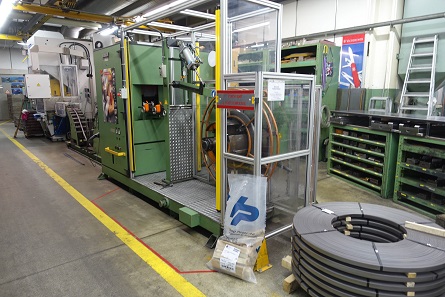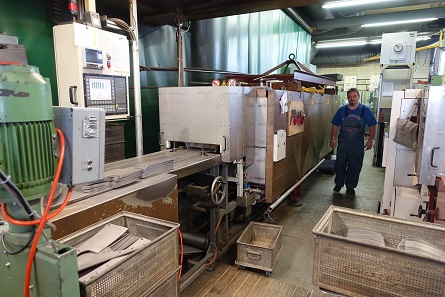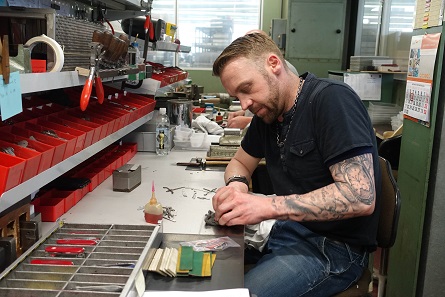by Ursula Kampmann
Translated by Leonie Schulze
September 13, 2018 – On September 10, 2018, Swissmint issued the 20 francs commemorative coin “Swiss Army Knife”. Artist Nadja Baltensweiler designed the changing side of the coin. She displayes the arguably most well-known type of the “Swiss Army Knife” as the motif, namely the “Huntsman” model.
Switzerland / 20 francs / 2018 “Swiss Army Knife” / 0.835 Ar / 20 g / 33 mm / Mintage: Uncirculated: 30,000, 5,000 in a folder. Proof: 5,000, 250 incl. artist’s certificate.
The obverse shows the opened pocketknife so as to demonstrate the array of functions hidden in this small technical marvel: a long and a short blade, a cork screw, a can opener (including a small screwdriver), a bottle opener (including a screwdriver and wire stripper), a reamer, tweezers, a toothpick, scissors, a multi-purpose hook and a saw.
The famous Swiss Army Knife made by Victorinox “Type Huntsman”. Photo: Victorinox.
The Swiss Army Knife enjoys cult status – and not just since the popular TV hero MacGyver began solving cases using a Swiss Army Knife in the 1980s. Victorinox is proud to say that they have been equipping Swiss soldiers with a pocketknife since 1891.
It is one of the most popular souvenirs tourists take home from Switzerland. And you cannot just buy it there: Airport and knife stores all over the world sell it. Today, 90 % of produced knives are exported, to over 120 countries at that!
Every day (!) about 28,000 Swiss Army Knives are made – in more than 100 different varieties and combinations. In addition, Victorinox produces 32,000 pocket tools and 60,000 kitchen and professional knives.
Two collectors’ items in one combo package: Commemorative coin and special edition knife. Photo: Swissmint.
There is no doubt the Swiss Army Knife, no matter which version, is one of the country’s most popular exports. Thus, it comes as no surprise that Swissmint has decided to use the English product name for the coin’s inscription.
On the occasion of this collaboration, CoinsWeekly was invited to visit the original production plant in Ibach in the spring of 2018. Therefore, we cannot only report on the new commemorative coin but also the manufacturing of the famous knife – which is not all that different from coin production.
A view of Schwyz and the mountains Kleiner Mythen and Grosser Mythen. Photo: Roland Zumbühl / CC-BY 3.0.
There are only a few places in Switzerland that are as Swiss as Schwyz, the canton in the middle of Switzerland that became the namesake of the entire country. The Federal Charter of 1291 is stored directly underneath the massif of the mountains Grosser and Kleiner Mythen. And the real reason why so many Japanese busses stop in this tiny town lies a two minutes’ drive away. This is not only the place where the original production plant of Victorinox is located. There is also a large factory outlet where one can marvel at and purchase the entire extensive product line.
The creator of the first Swiss Army Knife: Karl Elsener.
December 26, 2018 will be the centenary of the death of Victorinox’s founder, Karl Elsener.
The pioneer of Swiss industrialization founded a cutler’s workshop in Ibach in 1884.
Few people are aware of the fact that Switzerland was one of poorest regions in Europe in the 19th century. Many Swiss people had to emigrate because they could not find work. Only a few businessmen were willing to invest sufficient capital to be able to keep up with German and English competitors who could draw on much better infrastructure.
Elsener, who was born on October 9, 1860, had learned his trade in France and Germany and decided to locate his knife cutler’s workshop in his hometown of Ibach. He considered his market to be mainly Switzerland. His biggest potential customer was the army. But his own business was too small for him to be able to apply for army orders. Hence, Elsener convinced his competitors to seal the production of Swiss Army Knives by establishing an association. This Association of Swiss Cutlers exists to this day.
However, when a business from Solingen offered the product at a lower price due to its wide-reaching industrialization, the other competitors ran off. Elsener did not pull his offer, was awarded the contract and plunged into ruin attempting to compile the necessary infrastructure to be able to deliver the ordered knives. He owed it to loans from relatives that he averted bankruptcy – and the Swiss Army Knife set off on its triumphant road to success that would make Elsener’s knife cutler’s workshop known all over the world.
Today, the entire world knows “Victorinox”. And once again a world-renowned brand honors a woman whose personality provided the company’s founder with support and strength. Elsener’s mother was called Victoria. He combined her first name with the international name for stainless steel “inox”. And that is how he came up with “Victorinox”.
But let’s have a look at its production! Urs Wyss, head of the Victorinox PR department, took us on a guided tour through the plant.
A simple punch press sets off the production process. Photo: UK.
The warehouse is stacked with steel custom-made for Victorinox. Photo: UK.
Webbing and the raw product. Photo: UK.
Those who have at some point witnessed a blank being made can imagine what the first step of production looks like: a coil is inserted into a punch press and the knife blade is punched out.
Cleaning is up next. Photo: UK.
The next step, too, is reminiscent of coin production: the blanks are cleaned in a mix of abrasive and polishing media as well as compounds.
Here, the blade is being annealed. Photo: UK.
But as soon as we get to the question of how the always sharp blades of the Swiss Army Knife are produced, Urs Wyss’s statements become rather vague. After all, this is one of the most important secrets of the company. Annealing is definitely a part of it in some way. But the department where blades are sharpened is off-limits for visitors.
The toothpicks are not produced by Victorinox but purchased separately. Photo: UK.
Hence we have to take a mental leap forward: Let’s assume the knives have already been sharpened, toothpicks and cork screws have been delivered. Now every single one of the countless combinations of knives has to be assembled. This process has been automatized for the bestselling knives, thousands of which are produced every day (this too is a top secret process, but we were allowed a quick glimpse into the production hall). But the majority of knives manufactured in smaller quantities are assembled by hand.
The scales of the Swiss Army Knives. Photo: UK.
The knives’ plastic scales are not produced at Victorinox but purchased separately. There are not just the well-known red scales, but also yellow and blue ones, yet those colors are not as popular as the “original” red one.
Everyone can get “their” Victorinox knife made into a promotional gift. Photo: UK.
A certain number of ordered knives even allows for a customer to submit their own design of a Victorinox knife. Hence, knives are often ordered as promotional gifts. It comes as no surprise that the numerous varieties of knives made by Victorinox have become a popular collectors’ item.
The components are being assembled. Photo: UK.
Toothpick and tweezers are added. Photo: UK.
But first the different components of each knife have to be assembled – which is still done manually for most of the smaller pieces. Afterwards, the scales are attached. Tweezers and toothpicks also have to be inserted by hand.
Every item is inspected for its mobility in the end. This is the Rescue-Tool that was developed in collaboration with emergency and security services. Photo: UK.
In the end, every single item is checked. Before it leaves the production plant every single one of its functions is inspected. It is not surprising that the Swiss Army Knives are famous for their quality, durability and reliability.
Almost everyone has their own story to tell about a time when a Swiss Army Knife played a decisive role. Victorinox collects these stories. They tell us about a surgeon from Uganda who used the sow to amputate limbs, about a supersonic aviator who used it to repair his respiratory mask, and about countless NASA missions who ended well because of a Swiss Army Knife.
My story is not as life-threatening, but impressive nevertheless: we gave the knife to a farmer’s son as a gift who then lost it while working in the fields. He then found it again – but more than a year afterwards. He wiped it off and the Swiss Army Knife by Victorinox could be used again.
The repair service for the companion you have become fond of. Photo: UK.
Should your beloved companion nevertheless fail a task and break, Victorinox offers a repair service where every knife regardless of its date of purchase will be fixed.
If you want to learn more about the history of Victorinox, please visit their website.
You will also find the extensive product line of pocketknives there.
A much more detailed account is told by this documentary about the production of the Swiss Army Knife.
Victorinox runs its own YouTube channel with more than 18,000 subscribers. (We’re a little envious!)
Swissmint does not have a YouTube channel but a very nice and comprehensive website where you can also order the new commemorative coin.
They also offer a behind-the-scenes look. The entire coin production from the design to its packaging is shown and explained.
My personal favorite is the page of published “Numismatic Reports”.
If you want to compare whether it is true that the production of coin blanks is similar to the production of blades, read our article “From coils to blanks”.
If you submitted your order too late and the coin or set are already sold out, we recommend you try your luck at a coin dealer of the Verband Schweizer Berufsnumismatiker.






















